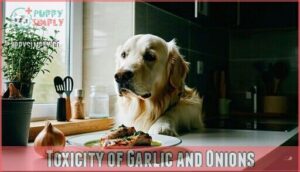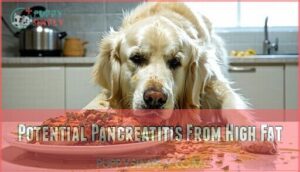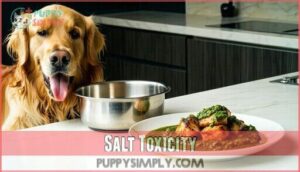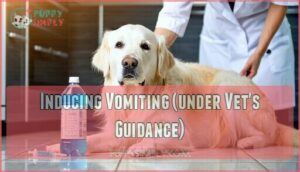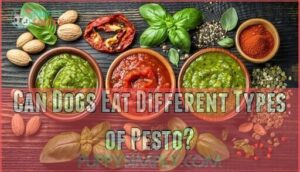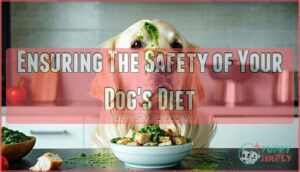This site is supported by our readers. We may earn a commission, at no cost to you, if you purchase through links.
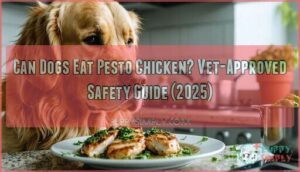 You shouldn’t let your dog eat pesto chicken because traditional pesto contains garlic and onions, which are toxic to dogs.
You shouldn’t let your dog eat pesto chicken because traditional pesto contains garlic and onions, which are toxic to dogs.
While plain chicken is perfectly safe for your furry friend, the pesto sauce turns this healthy protein into a potential danger zone.
Garlic and onions can cause serious health issues, from stomach upset to life-threatening anemia.
The high fat content in pesto can also trigger pancreatitis, especially in smaller dogs who are more sensitive to these ingredients.
If your pup accidentally snags some pesto chicken, watch for symptoms like vomiting or lethargy.
There are safer ways to share chicken with your dog that won’t put their health at risk.
Table Of Contents
- Key Takeaways
- Is Pesto Safe for Dogs?
- Risks of Feeding Pesto to Dogs
- What to Do if Your Dog Eats Pesto
- Can Dogs Eat Different Types of Pesto?
- Ensuring The Safety of Your Dog’s Diet
- Frequently Asked Questions (FAQs)
- Is pesto chicken safe for dogs?
- What happens if my dog eats a little bit of pesto?
- Can dogs eat basil chicken?
- Can dogs eat tomato and pesto?
- What are the symptoms of toxicity from eating pesto?
- What are the risk factors associated with feeding pesto to dogs?
- Are there any alternatives to pesto that I can feed my dog?
- What ingredients are safe to include in pesto for dogs?
- When should I call the vet if my dog has eaten pesto?
- How much pesto chicken is safe daily?
- Conclusion
Key Takeaways
- Don’t feed your dog pesto chicken – the garlic and onions in traditional pesto are toxic to dogs and can cause life-threatening anemia by damaging their red blood cells.
- Watch for emergency symptoms if your dog accidentally eats pesto chicken – contact your vet immediately if you notice vomiting, diarrhea, pale gums, lethargy, or rapid breathing.
- High fat content creates additional risks – pesto’s rich olive oil and cheese can trigger pancreatitis in dogs, especially smaller breeds who are more sensitive to fatty foods.
- Stick to plain chicken instead – cooked chicken without seasonings, garlic, or sauces is perfectly safe and healthy for your dog as a protein-rich treat.
Is Pesto Safe for Dogs?
Pesto contains several ingredients that can harm your dog, including garlic and onions which are toxic to canines.
While a small taste won’t likely cause serious problems, regular consumption of pesto can lead to health issues like anemia, pancreatitis, and salt poisoning.
Onion and Garlic Poisoning
Before you share that pesto chicken with your pup, understand that garlic and onions pack a dangerous punch.
These toxic foods contain thiosulfate, which damages red blood cells and can trigger life-threatening anemia symptoms. Even small amounts matter—garlic poisoning occurs at just 0.5% of your dog’s body weight as the toxic dose. Powder potency makes seasoning blends especially risky.
Just 0.5% of your dog’s body weight in garlic can trigger dangerous poisoning—powder forms are even riskier.
Alliums contain toxins that cause red blood cell damage.
Watch for these critical warning signs:
- Vomiting and diarrhea within 24 hours
- Pale or yellow gums indicating anemia
- Lethargy and weakness from damaged red blood cells
- Rapid breathing as oxygen delivery struggles
- Loss of appetite and abdominal pain
Pancreatitis
Pesto’s high fat content poses serious dog health risks beyond garlic toxicity.
The rich olive oil and cheese can trigger pancreatitis, causing severe abdominal pain, vomiting, and fever.
This painful inflammation requires immediate veterinary diagnosis and treatment.
Prevention means avoiding high-fat diet indiscretions like pesto for dogs.
Symptoms include lethargy, loss of appetite, and hunched posture.
Toxic ingredients combined with excessive fat create a dangerous combination for your pet’s pancreas.
Even small amounts pose risks to canine health, emphasizing the need for careful dietary management.
Salt Poisoning
Salt poisoning becomes a real concern when your dog’s sodium levels spike beyond their body’s ability to process excess salt. Pesto’s high salt content can quickly push your pup past their toxicity threshold, triggering dehydration risks that escalate rapidly.
High sodium in pesto can overwhelm your dog’s system, causing dangerous dehydration and potentially life-threatening salt poisoning.
Without immediate water access, your dog’s kidneys struggle to maintain proper fluid balance. Watch for telltale dog symptoms like excessive thirst, disorientation, and muscle tremors. Pesto toxicity in dogs often manifests through these warning signs, making veterinary intervention critical when pesto risks dogs’ health through dangerous sodium overload.
- Excessive thirst signals your dog’s body fighting salt overload
- Disorientation and wobbling indicate neurological impact from high sodium
- Muscle tremors suggest your pup’s electrolytes are dangerously imbalanced
- Rapid breathing shows their system working overtime to process toxins
- Loss of coordination means immediate vet attention is non-negotiable
Soy Allergy
Beyond salt concerns, vegan pesto presents another hidden danger for your furry friend.
Soy allergy affects roughly 6% of food-allergic dogs, making it a real concern when your pup encounters soy-based cheese alternatives in plant-based pesto recipes.
Soy Allergy Symptoms include stomach upset, itchy skin, ear infections, and excessive paw licking.
You might notice poor coat condition or unexpected weight loss if your dog has developed soy intolerance over time.
Diagnosing Soy Allergy requires veterinary food trials and elimination diets lasting about 60 days.
Managing Soy Allergy means completely removing soy from your dog’s diet.
When considering Vegan Pesto Concerns, remember that even plant-based versions contain toxic garlic and onions.
Soy-Free Alternatives like traditional cheese-based pesto aren’t safer due to other harmful ingredients.
Always consult your vet about dog food allergies before introducing new foods.
Risks of Feeding Pesto to Dogs
While that pesto chicken might smell amazing to you, several ingredients in traditional pesto can pose serious health risks to your dog.
From garlic toxicity to pancreatitis from high fat content, understanding these dangers helps you make informed decisions about what treats are safe for your furry friend, and this knowledge is key to informed decisions.
Toxicity of Garlic and Onions
When your dog encounters garlic and onions in pesto, you’re dealing with serious toxicity risks.
These Allium family plants contain compounds that attack your dog’s red blood cells, potentially causing life-threatening anemia symptoms.
Here’s what makes pesto toxicity dogs face so dangerous:
- Garlic is 3-5 times more toxic than onions to canines
- Powder potency increases toxicity levels substantially compared to fresh forms
- Thiosulfate toxicity damages red blood cells through oxidative stress
- Cumulative effects occur from repeated small exposures over time
- Garlic poisoning symptoms appear 5-6 days after onion consumption
Even small amounts can cause oxidative damage to red blood cells.
Potential Pancreatitis From High Fat
Feeding your dog pesto chicken creates serious dietary risks due to the high fat content in traditional pesto recipes.
This rich combination can overwhelm your pet’s digestive system and trigger dangerous pancreas strain, leading to acute pancreatitis—a potentially life-threatening condition.
When dogs consume high-fat foods like pesto, their pancreas works overtime to produce digestive enzymes. Here’s what happens during a pancreatitis episode:
- Inflammation develops in the pancreas within hours of eating fatty foods
- Vomiting and diarrhea become persistent and severe
- Abdominal pain causes your dog to hunch or refuse movement
- Lethargy and loss of appetite signal systemic distress
- Dehydration occurs rapidly from fluid loss
Certain breeds show breed predisposition to pancreatitis, making prevention strategies essential.
If your dog ate pesto, contact your veterinarian immediately. Canine pancreatitis requires professional treatment—don’t wait for symptoms to worsen. Recovery depends on early intervention and switching to appropriate low-fat diets; consider a low-fat diet to support pancreatic health.
Salt Toxicity
High sodium levels in pesto create serious dehydration risks for your furry friend.
Salt poisoning occurs when dogs consume just 2-3 grams of salt per kilogram of body weight.
Watch for vomiting, diarrhea, and tremors within hours of consumption.
Veterinary intervention becomes critical if these dog poisoning symptoms appear.
Always provide safe hydration through fresh water access, as toxicity makes pesto bad for dogs and poses significant dog health risks.
Allergic Reactions to Soy
While salt poisoning poses immediate dangers, soy allergies present another serious concern for your furry friend.
Many vegan pesto varieties contain soy-based ingredients that can trigger severe allergic reactions in sensitive dogs.
Watch for these soy allergy symptoms:
- Hives or skin rashes appearing suddenly
- Difficulty breathing or wheezing sounds
- Facial swelling, especially around the muzzle
- Vomiting, diarrhea, or excessive drooling
Anaphylaxis risks increase with repeated exposure, making early detection essential.
Cross-reactivity with other legumes complicates matters further.
Hidden soy sources lurk in many processed foods, so check labels carefully.
Consider allergy testing if you suspect your dog has food sensitivities before introducing new ingredients.
What to Do if Your Dog Eats Pesto
If your dog accidentally eats pesto, don’t panic but act quickly to assess the situation and determine your next steps.
Contact your veterinarian immediately to report the amount consumed and get professional guidance on whether emergency treatment is necessary.
Immediate Actions
When your dog eats pesto chicken, time matters. Contact your vet or pet poison control immediately – don’t wait for symptoms to appear. Quick emergency response can prevent serious complications from pesto poisoning dogs.
| Action | Timeline |
|---|---|
| Call vet/poison control | Within 5 minutes |
| Monitor symptoms | Continuously for 24 hours |
| Induce vomiting | Only if vet directs |
| Provide water | Immediately available |
| Emergency care | If symptoms worsen |
Watch for vomiting, diarrhea, lethargy, and excessive thirst. Never induce vomiting without professional guidance – it can worsen certain situations. Keep your dog calm and provide fresh water.
Document what they ate, how much, and when. Small dogs face higher risks, so vet consultation becomes even more critical for tiny breeds.
Contacting a Vet
If your dog gets into pesto chicken, don’t wait—call your vet immediately. Knowing when to call can make all the difference, especially with risks like pet poisoning or pancreatitis.
Watch for emergency signs like vomiting, diarrhea, pale gums, or a racing heart. If your vet isn’t available, reach out to an online vet or a pet poison control hotline for guidance.
Veterinary care may include follow-up care to monitor symptoms or manage complications. Worried about cost concerns? Many emergency vet clinics offer payment plans, so don’t hesitate to prioritize your pup’s health over financial worries.
Time matters—act fast!
Inducing Vomiting (under Vet’s Guidance)
Never attempt to make your dog vomit without professional guidance when dogs eat pesto containing toxic ingredients.
Veterinarians may recommend hydrogen peroxide in specific dosage calculation scenarios, but this carries serious aspiration risks if done incorrectly.
The procedure is contraindicated when your pet has already vomited, shows difficulty swallowing, or consumed sharp objects.
Emergency vet consultation prevents dangerous complications from improper pet poisoning treatment.
Post-vomiting care requires monitoring for continued symptoms and guaranteeing adequate hydration.
Professional dog veterinary care guarantees safe vomiting induction protocols adapted to your pet’s specific situation and health status.
If approved by a vet, consider using 3% hydrogen peroxide to induce vomiting.
Alternatives to Pesto
Skip the risky pesto and create delicious dog-friendly sauces your pup will love.
These homemade toppers offer safe ingredients without dietary restrictions concerns:
- Basil-olive oil blends with nutritional yeast for cheesy flavor
- Safe herbs like parsley mixed with plain Greek yogurt
- Pumpkin puree combined with chicken broth for moisture
- Sweet potato mash with a drizzle of olive oil
These pesto alternatives for dogs eliminate dog allergies while delivering taste and nutrition your furry friend deserves.
Consider a dog pesto alternative if you’re looking for commercial options.
Can Dogs Eat Different Types of Pesto?
You might wonder if different pesto varieties affect your dog’s safety differently, but unfortunately, most pesto types contain the same harmful ingredients.
Whether you’re dealing with traditional basil pesto, red pesto made with sundried tomatoes, or vegan alternatives, they typically include garlic and onions that remain toxic to dogs regardless of the recipe variation.
Basil Pesto
Traditional basil pesto poses serious risks for your dog’s health.
While basil itself is safe, the garlic in classic basil pesto recipes can damage red blood cells and cause anemia.
Making basil pesto at home allows you to control ingredients, but even garlic-free versions contain high-fat olive oil and cheese that may trigger pancreatitis.
Pesto nutritional value includes beneficial antioxidants from basil, yet the risks outweigh benefits.
Is pesto safe for dogs? Not in its traditional form – dog health depends on avoiding garlic-containing variations entirely.
Red Pesto
Red pesto presents different challenges than its green counterpart.
While sun-dried tomatoes replace basil as the main ingredient, garlic remains the primary concern for dogs.
Tomato toxicity in red pesto is generally mild, causing minor digestive upset rather than serious poisoning.
However, the concentrated garlic content makes this variation equally dangerous for your pup.
Red pesto ingredients typically include higher sodium levels and more concentrated flavors than traditional versions.
Safe quantities don’t exist when garlic is present.
For homemade alternatives, substitute garlic with dog-safe herbs like parsley.
Remember, even small amounts of garlic-containing red pesto can trigger toxic foods for dogs reactions, affecting dog health substantially.
Vegan Pesto
Vegan pesto might seem like a safer bet for your furry friend, but it’s not automatically dog-friendly. Many vegan recipes still contain garlic and onions, which pose the same toxicity risks as traditional versions.
Tofu pesto and nutritional yeast-based alternatives can be gentler options, though soy concerns remain valid since some dogs develop allergic reactions to soy products. Watch for allergy risks like hives, difficulty breathing, or swelling if your dog consumes vegan pesto containing soy.
The safest approach involves making homemade vegan recipes using only safe ingredients like basil, olive oil, and pine nuts while completely avoiding garlic, onions, and excessive salt. Always check labels carefully before sharing any pesto with dogs to minimize the risk of toxicity and ensure a healthy treat.
Ensuring The Safety of Your Dog’s Diet
You need to understand which pesto ingredients pose risks to your dog’s health and which ones can be safely shared.
Making informed choices about what goes into your dog’s bowl protects them from potential toxicity while still allowing you to include them in family meal times, ensuring you make informed decisions.
Safe Ingredients in Pesto
When asking "is pesto safe dogs," focus on the good stuff first.
Basil benefits include anti-inflammatory properties, making it safe in small amounts.
Olive oil provides healthy fats your dog can handle.
Cheese options like small amounts of Parmesan won’t hurt most pups.
Nut choices such as pine nuts offer protein.
Safe herbs like basil won’t cause garlic poisoning or onion toxicity.
These pesto ingredients dogs can actually enjoy make safer alternatives possible.
Unsafe Ingredients in Pesto
Why does something so delicious pose such risks to your furry friend?
Several pesto ingredients spell trouble for dogs. Garlic toxicity and onion poisoning top the danger list, as these compounds destroy red blood cells and cause serious gastrointestinal upset.
Salt concerns arise from high sodium levels that can lead to dehydration or worse. The fat content in nuts and oils may trigger pancreatitis, while soy allergies affect sensitive dogs with symptoms ranging from itching to breathing difficulties.
Even small amounts of these problematic ingredients can result in dog poisoning, making vigilance essential. Additionally, pesto’s high-fat content from pine nuts can also be dangerous.
Substitutions for Problematic Ingredients
Creating dog-friendly pesto becomes simple with smart substitutions.
Replace toxic garlic with fresh parsley or basil, and swap onions for pine nuts or almond slivers.
Choose nutritional yeast over Parmesan to reduce salt, while chicken breast adds protein.
Consider using a safe garlic alternative to enhance the flavor.
These safe alternatives let you share pesto joy without risking your pup’s health through dangerous ingredients.
Serving Tips for Pesto
After choosing safe ingredients, proper serving tips make all the difference when offering pesto chicken to your dog.
Smart preparation protects your pup from harmful effects while maximizing nutrition.
- Start with tiny pesto portion sizes – a teaspoon for small dogs, tablespoon for large breeds
- Choose safe pesto brands or follow a homemade pesto guide using dog-friendly ingredients
- Focus on pesto ingredient quality and gentle chicken preparation methods
- Monitor your dog’s reaction closely after serving
Consider dog pesto products for convenient options.
Frequently Asked Questions (FAQs)
Is pesto chicken safe for dogs?
Pesto chicken isn’t safe for dogs.
The pesto contains garlic and onions, which are toxic and can damage your dog’s red blood cells.
Stick to plain chicken instead—it’s much safer.
What happens if my dog eats a little bit of pesto?
If your dog eats a small amount of pesto, monitor them closely for vomiting, diarrhea, or lethargy.
Contact your vet immediately, especially if the pesto contained garlic or onions, which are toxic to dogs.
Can dogs eat basil chicken?
Like a green light for pet parents, basil chicken gets the thumbs up.
You’ll find basil’s actually safe for your pup in small amounts.
Just skip the garlic, onions, and heavy seasonings that often tag along with chicken dishes.
Can dogs eat tomato and pesto?
Tomato and pesto aren’t safe for your dog.
While tomatoes are generally okay in small amounts, pesto contains garlic and onions that can damage your pup’s red blood cells, causing serious health problems.
What are the symptoms of toxicity from eating pesto?
When your furry friend’s eaten the forbidden green sauce, watch for vomiting, diarrhea, lethargy, and pale gums.
You’ll also notice weakness, rapid breathing, loss of appetite, and abdominal pain requiring immediate veterinary attention.
What are the risk factors associated with feeding pesto to dogs?
Small breeds face higher risks due to their size, while dogs with heart or kidney conditions can’t handle pesto’s high sodium content.
Pre-existing health issues amplify toxicity effects from garlic and excessive fat intake.
Are there any alternatives to pesto that I can feed my dog?
Coincidentally, many dog owners discover safer alternatives when researching pesto risks.
You can offer plain grilled chicken, low-sodium chicken broth with herbs like parsley or cilantro, or homemade dog-safe "pesto" using basil and olive oil only.
What ingredients are safe to include in pesto for dogs?
For dog-safe pesto, you’ll want basil, olive oil, and plain cooked chicken breast.
Skip garlic, onions, salt, and high-fat cheese.
These simple swaps create a tasty, pet-friendly version your pup can enjoy safely.
When should I call the vet if my dog has eaten pesto?
Like a red warning light flashing, contact your vet immediately if your dog consumed pesto containing garlic or onions.
Don’t wait for symptoms—call within hours, especially for small breeds or large amounts consumed.
How much pesto chicken is safe daily?
You shouldn’t give your dog pesto chicken daily.
The garlic and high fat content make it risky for regular consumption.
Offer plain chicken as a safer alternative, and save pesto chicken for rare occasions only.
Conclusion
Ironically, the very ingredients that make pesto irresistibly delicious to humans are precisely what make it dangerous for dogs.
While you might want to share your favorite meal, can dogs eat pesto chicken safely? The answer remains a firm no.
Stick to plain, cooked chicken for your furry friend instead. Your dog’s health depends on keeping garlic, onions, and high-fat sauces off their plate.
Sometimes the best way to show love is saying no to sharing, as this simple act can be life-saving for your pet.
- https://vcacanada.com/know-your-pet/the-importance-of-your-pets-skin-and-coat-and-the-role-of-diet
- https://pangovet.com/?utm_source=dogster&utm_medium=article&utm_campaign=dog_eat_drink
- https://petkeen.com/human-foods-that-are-safe-for-dogs-to-eat/
- https://www.epa.gov/emergency-response
- https://droughtmonitor.unl.edu/

